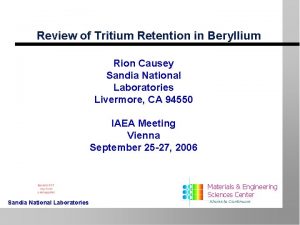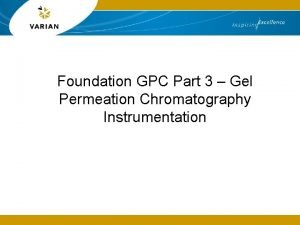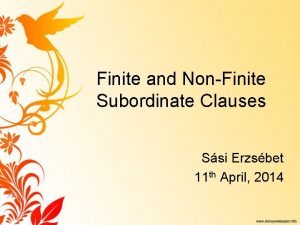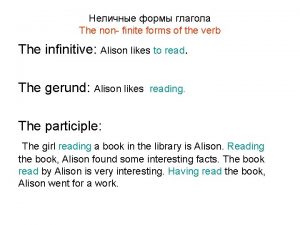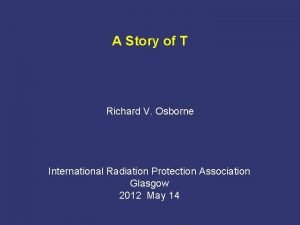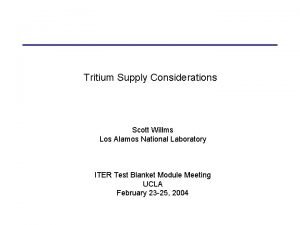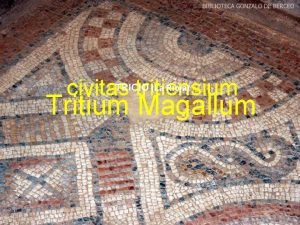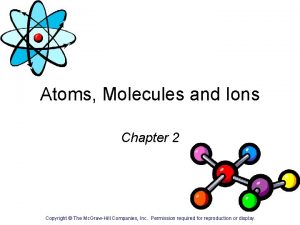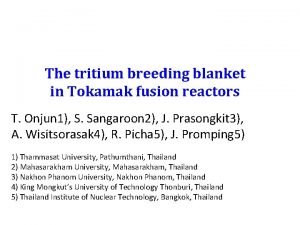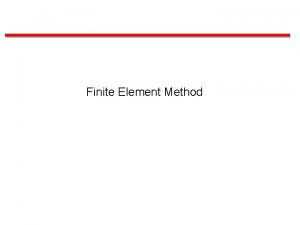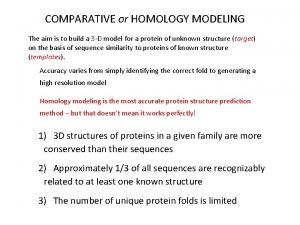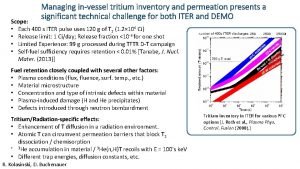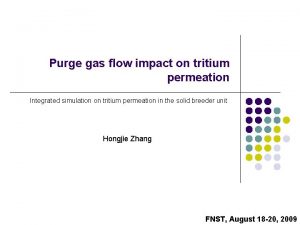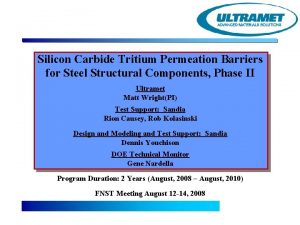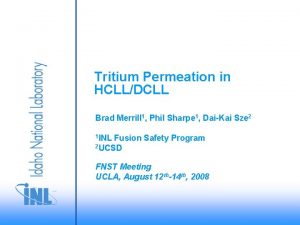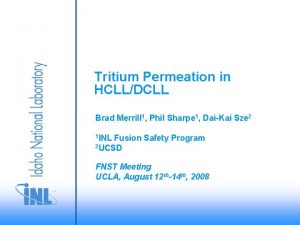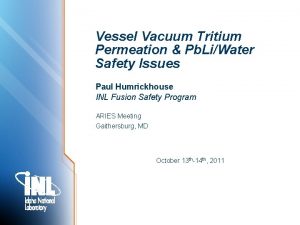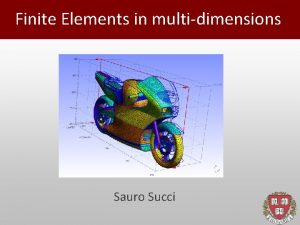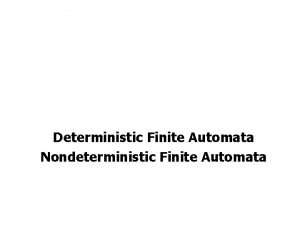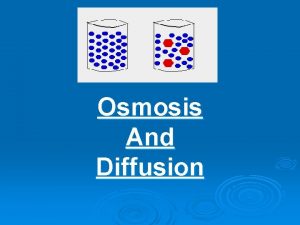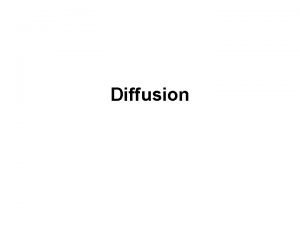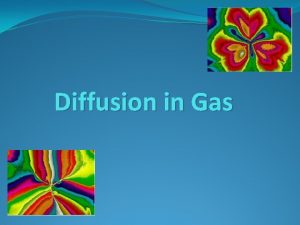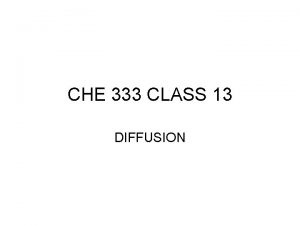Finite Elements Modelling of Tritium Permeation Tritium diffusion

















- Slides: 17

Finite Elements Modelling of Tritium Permeation Tritium diffusion and convection in Li. Pb Wilfrid Farabolini – Frédéric Dabbene Direction de l’Energie Nucléaire Club Castem 26 nov. 04 Wilfrid Farabolini 1

A Fusion Power Reactor Direction de l’Energie Nucléaire Club Castem 26 nov. 04 Wilfrid Farabolini 2

Schematic Fluids Circulation in the PPCS Reactor HCLL Blanket modules MLi. Pb J 3 JFW J 1 Li. Pb purification a QPb. Li Pump J 2 h. Li. Pb Tritium extraction from Li. Pb QPb. Li Steam generator J 4 air purification J 5 h. He He purification a QHe Secondary circuit QHe MHe Blower J 1 = 610 g/day (4000 MW fusion power) QHe = 4000 kg/s (Tin = 300°C, Tout = 500°C, P= 8. 0 MPa Direction de l’Energie Nucléaire Club Castem 26 nov. 04 Wilfrid Farabolini 3

Concept of the HCLL Blanket Modules Demo Module Direction de l’Energie Nucléaire Breeding Unit Club Castem 26 nov. 04 Wilfrid Farabolini 4

Analytical Model – Tritium Mass Balance Equations 1/2 J 1 J 3 Li. Pb J 5 He J 2 J 4 J 1 / J 5 =222650 J 1 = 610 g / day • J 1 : Production rate • J 2 : Extraction from Li. Pb h. Li. Pb : extractor efficiency for Li. Pb Cout : Tritium output concentration in Li. Pb (mol m-3), GLi. Pb : Li. Pb flow rate (m 3 s-1) • J 3 : Permeation towards He coolant Cave : Tritium average concentration in Li. Pb (mol m-3) Kblanket: Blanket permeation factor (m 3 s-1) • J 4 : Extraction from He coolant GHe : He flow rate to detritiation unit (m 3 s-1) • J 5 : Release to environment LSG: KSG: Steam Generator leak flow (m 3 s-1) SG permeation factor (m 3 s-1) Direction de l’Energie Nucléaire ( J 5 max = 1 g/year=27 Ci/day , ITER standard ) Club Castem 26 nov. 04 Wilfrid Farabolini 5

Analytical Model – Tritium Mass Balance Equations 2/2 • • A, s : respectively wall surface (m 2) and wall thickness (m). Kssteel Ks. Li. Pb : Sievert constants (mol m-3 Pa-1/2), respectively in Eurofer and in Li. Pb Dsteel Tritium diffusivity in Eurofer (m 2 s-1) PRFb is the Permeation Reduction Factor provided by permeation barrier (if any) Stationary results (*) : * Thanks to Italo Ricapito (ENEA consultant) who initiated these computations Direction de l’Energie Nucléaire Club Castem 26 nov. 04 Wilfrid Farabolini 6

Computation of Kblanket for PPCS For Tave=480 °C Ksteel Dsteel/KLipb = 2. 7 10 -8 m 2 s-1 Kblanket = 1. 09 /PRF m 3 s-1 Direction de l’Energie Nucléaire Club Castem 26 nov. 04 Wilfrid Farabolini 7

Tritium flow towards He coolant (J 3) • • • Kblanket = 1. 09 / PRFb m 3 s-1 (Tave = 480 °C, 180 modules) h. Li. Pb = 0. 8 (reasonable efficiency for packed column extractor) GLi. Pb limitation due to Li. Pb velocity (MHD pressure drops and corrosion) 10 recycling/day 0. 063 m 3 s-1 72 recycling/day 0. 454 m 3 s-1 Direction de l’Energie Nucléaire Club Castem 26 nov. 04 Wilfrid Farabolini 8

Justification of the FEM Study • Previous analytical computations made the assumption that all the produced tritium is immediately available for permeation through the Eurofer walls. • Actually, T has to travel through the Li. Pb bulk before reaching the walls. • Considering that: – T diffusivity in Li. Pb is about 10 times smaller than in Eurofer. – Li. Pb layer thickness is 40 times larger than Cooling Plates wall thickness in present Breeding Unit design. • Ignoring these facts might lead to very pessimistic results (nearly all the produced T escapes into the He coolant, if no permeation barriers are used). He coolant flow Li. Pb velocity T permeation through wall T transport via diffusion and convection through Li. Pb T produced in Li. Pb Direction de l’Energie Nucléaire Club Castem 26 nov. 04 Wilfrid Farabolini 9

CAST 3 M Model of the BU used for the study equivalent thickness considering He channels shape p null T concentration computed T permeation flux 1. 08 mm imposed input T concentration 20 mm Li. Pb velocity with various possible profiles (Poiseuille, Flat, Hartmann) margin for numerical stability computed T convection flux r 100 mm 600 mm FW position type of mesh used for analytical-like computation (homogeneous T concentration ) T-source term type of mesh used for T diffusion computation (stratified T concentration ) Q(r) = Qmax exp (– 4. 5 r) r Direction de l’Energie Nucléaire Club Castem 26 nov. 04 Wilfrid Farabolini 10

Cast 3 M results – homogeneous T concentration v = 0. 25 mm/s 18 recycling/day v = 1. 0 mm/s 72 recycling/day v = 0. 25 mm/s Direction de l’Energie Nucléaire 83. 2 % of permeation Maximum T concentration does not reached the outlet 39. 9 % of permeation v = 1. 0 mm/s Club Castem 26 nov. 04 Wilfrid Farabolini 11

Diffusion with Poiseuille velocity profile v = 0. 25 mm/s 18 recycling/day 15. 4 % of permeation v = 1. 0 mm/s 72 recycling/day 9. 4 % of permeation Direction de l’Energie Nucléaire Club Castem 26 nov. 04 Wilfrid Farabolini 12

Some velocity profiles induced by MHD Hartmann wall Side wall from Magnetofluiddynamics in Channels and Containers, U. Müller, L. Bühler, Springer Direction de l’Energie Nucléaire Club Castem 26 nov. 04 Wilfrid Farabolini 13

Diffusion with flat velocity profile v = 0. 25 mm/s 18 recycling/day 10. 3 % of permeation v = 1. 0 mm/s 72 recycling/day Direction de l’Energie Nucléaire 5. 0 % of permeation Club Castem 26 nov. 04 Wilfrid Farabolini 14

Permeation vs. Li. Pb Velocity for various cases h= 1. 0 forward and backward circulation (mm s-1) 10 recycling/day 0. 063 m 3 s-1 Direction de l’Energie Nucléaire 72 recycling/day 0. 454 m 3 s-1 Club Castem 26 nov. 04 Wilfrid Farabolini 15

Application of ITER duty factor (400 s / 1800 s) v = 0. 2 mm/s Direction de l’Energie Nucléaire v = 0. 04 mm/s Club Castem 26 nov. 04 Wilfrid Farabolini 16

Conclusions • Taking into account T diffusion in the Li. Pb bulk drastically reduces the permeation rate as previously analytically computed. • Further works are to be completed to assess the Li. Pb flow (thermal convection with MHD, duct expansion/contraction, possible stagnation areas) • Further refinement can be introduced in the model (temperature chart for diffusivity, input T concentration, Stiffening Plates, 3 D) • However, higher confidence in these results can only come from experimentation • Cast 3 M allows to fit TBM experiments in ITER in order to find Power Reactor equivalent working points Direction de l’Energie Nucléaire Club Castem 26 nov. 04 Wilfrid Farabolini 17
 Permeation tubes
Permeation tubes Permeation movie
Permeation movie Gel chromatography instrumentation
Gel chromatography instrumentation Learning objectives for finite and non finite verbs
Learning objectives for finite and non finite verbs Finite and nonfinite verbs
Finite and nonfinite verbs Finite and non finite subordinate clauses
Finite and non finite subordinate clauses Non finite forms of the verb qayda
Non finite forms of the verb qayda Finite verb
Finite verb Facilitated diffusion
Facilitated diffusion Relocation diffusion vs expansion diffusion
Relocation diffusion vs expansion diffusion Tritium half life
Tritium half life Tritium
Tritium Tritium magallum
Tritium magallum Protium deuterium tritium
Protium deuterium tritium Tritium breeding blanket
Tritium breeding blanket Finite element method
Finite element method Universal modelling language
Universal modelling language Homology modelling steps
Homology modelling steps
